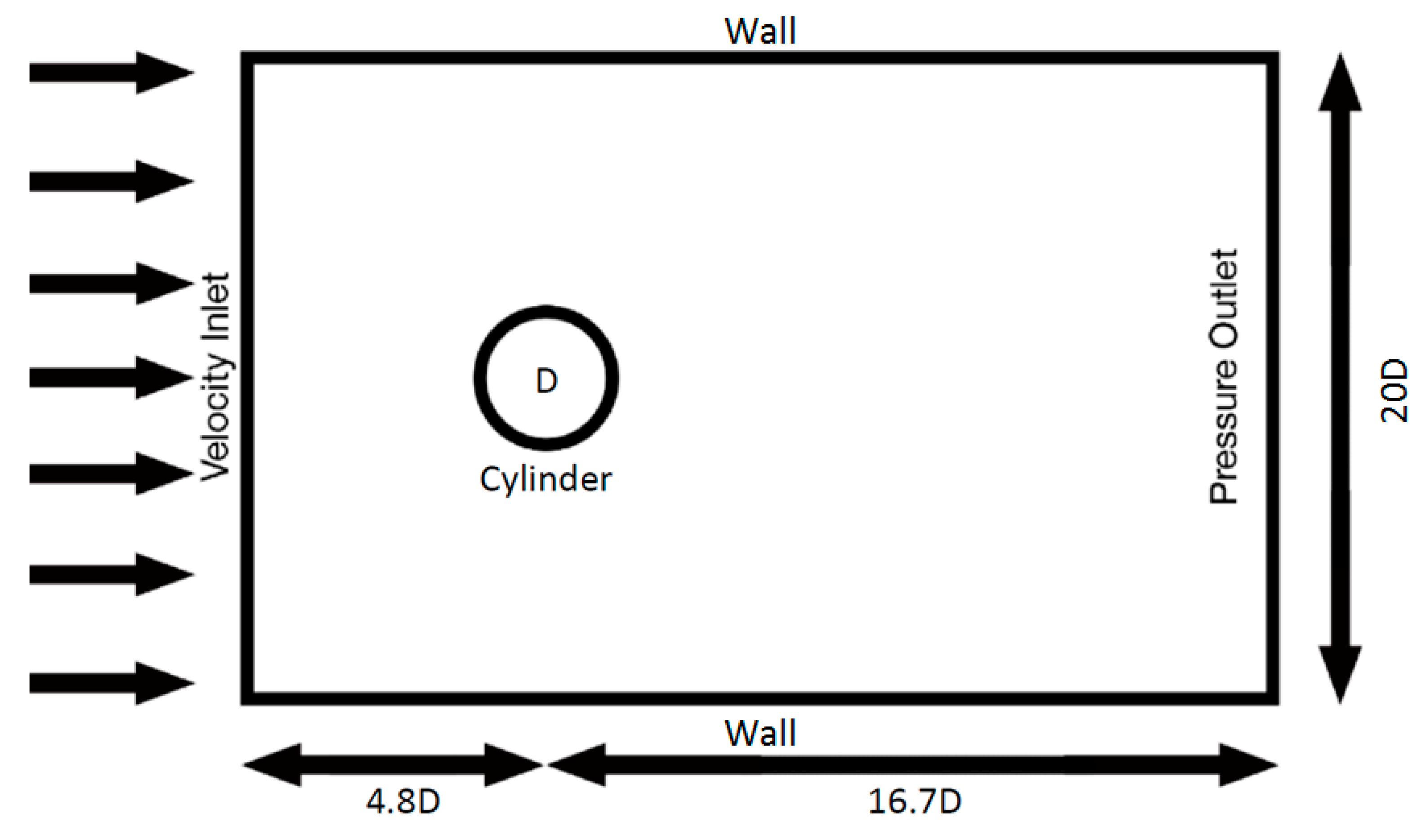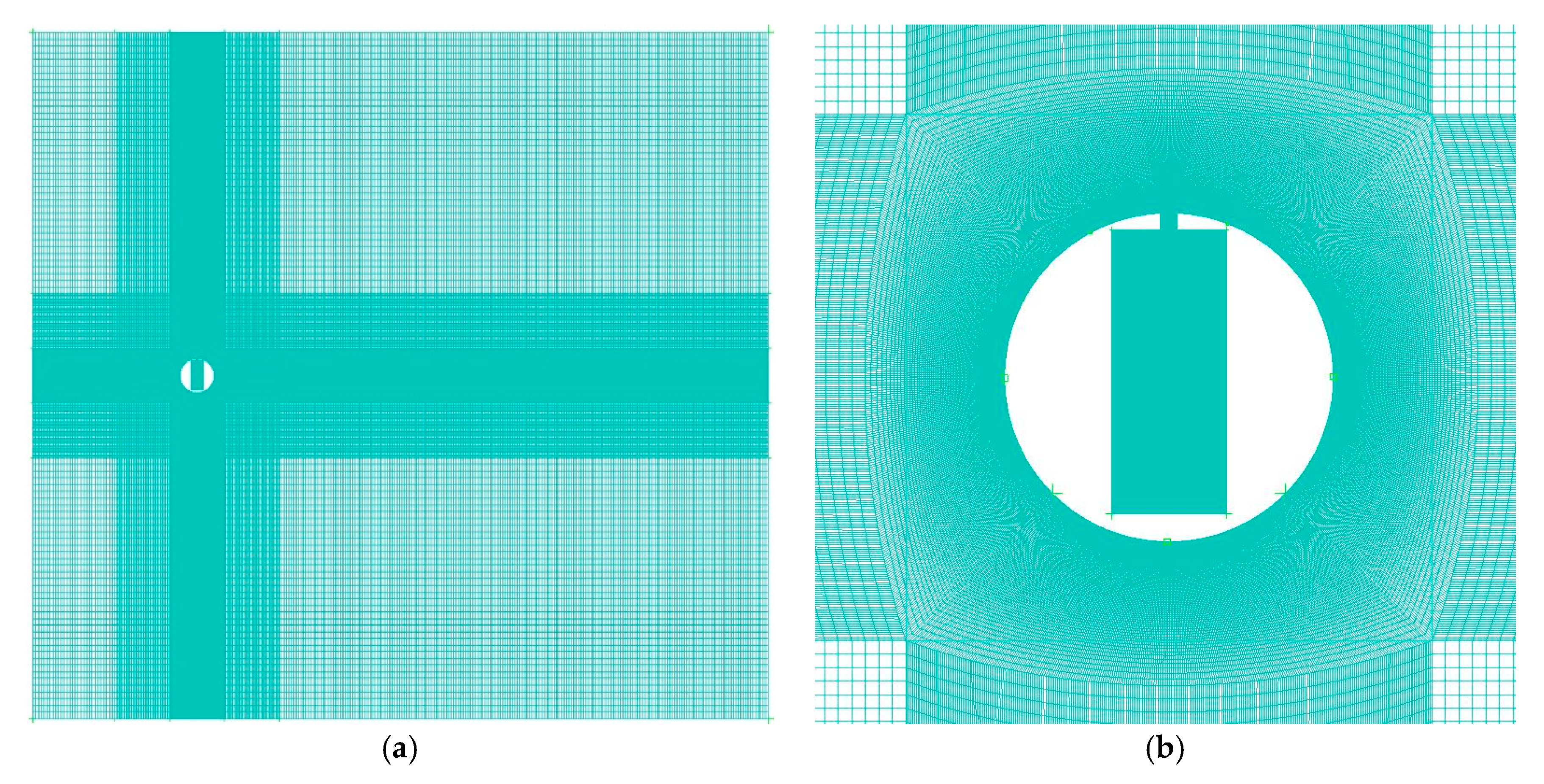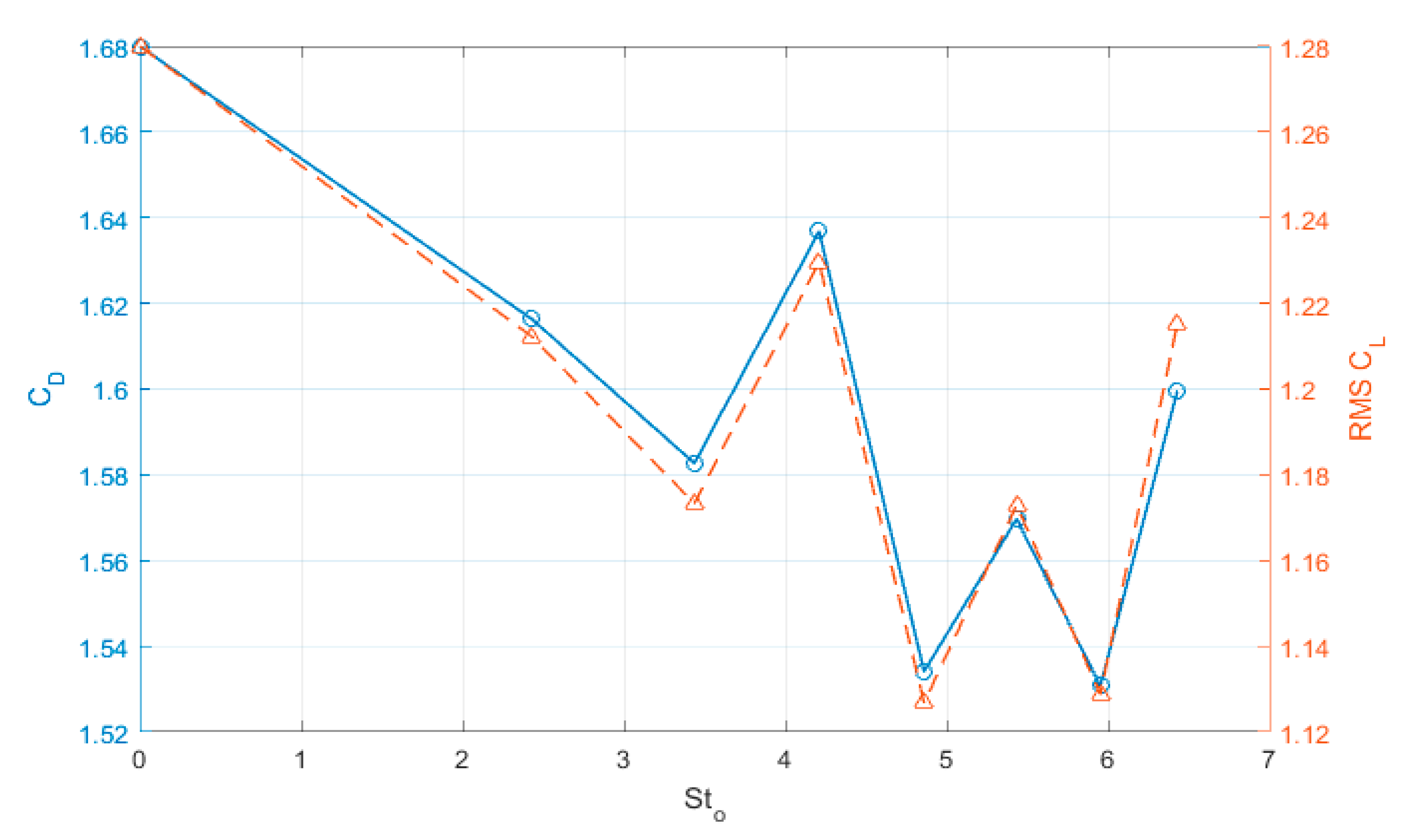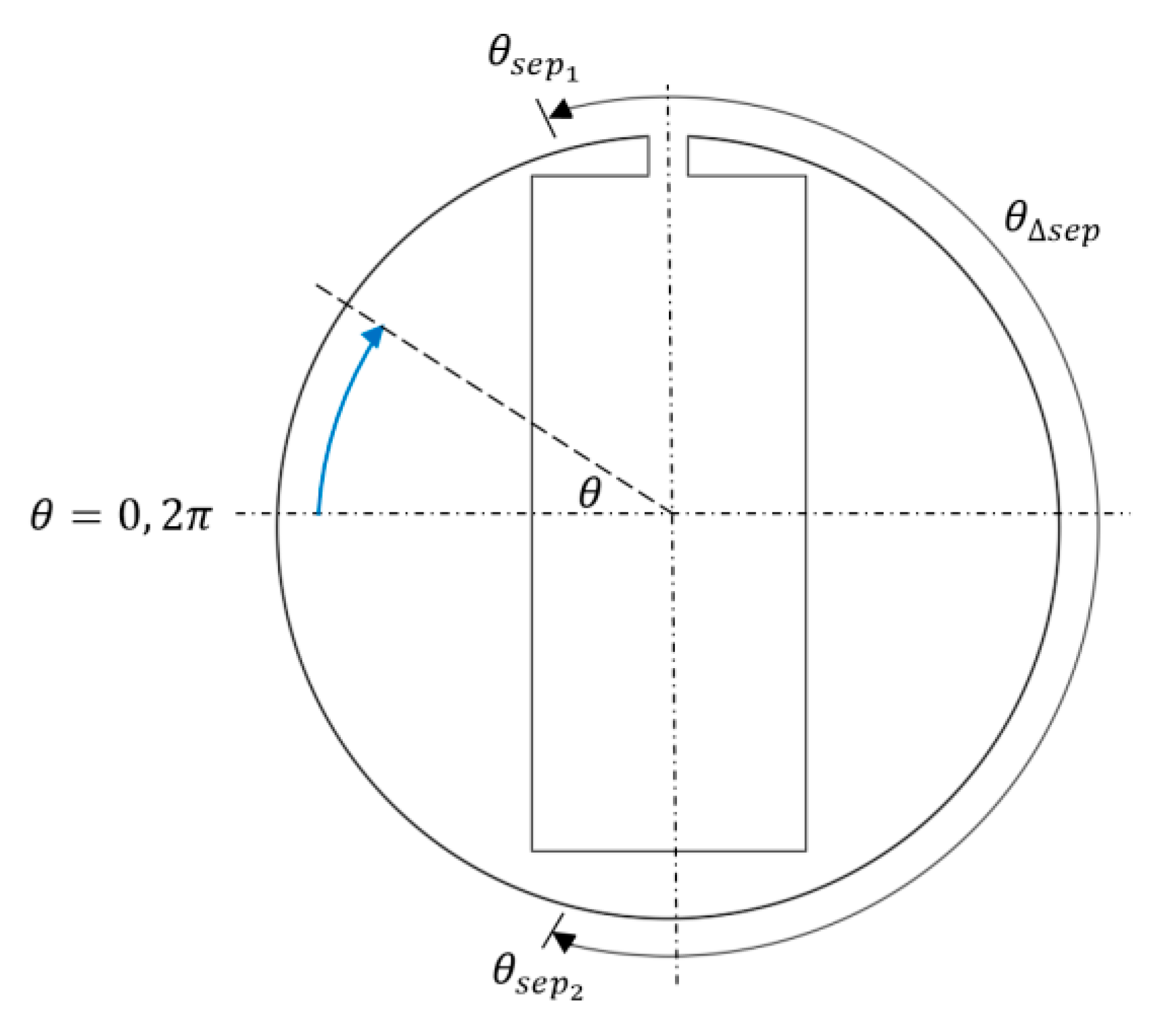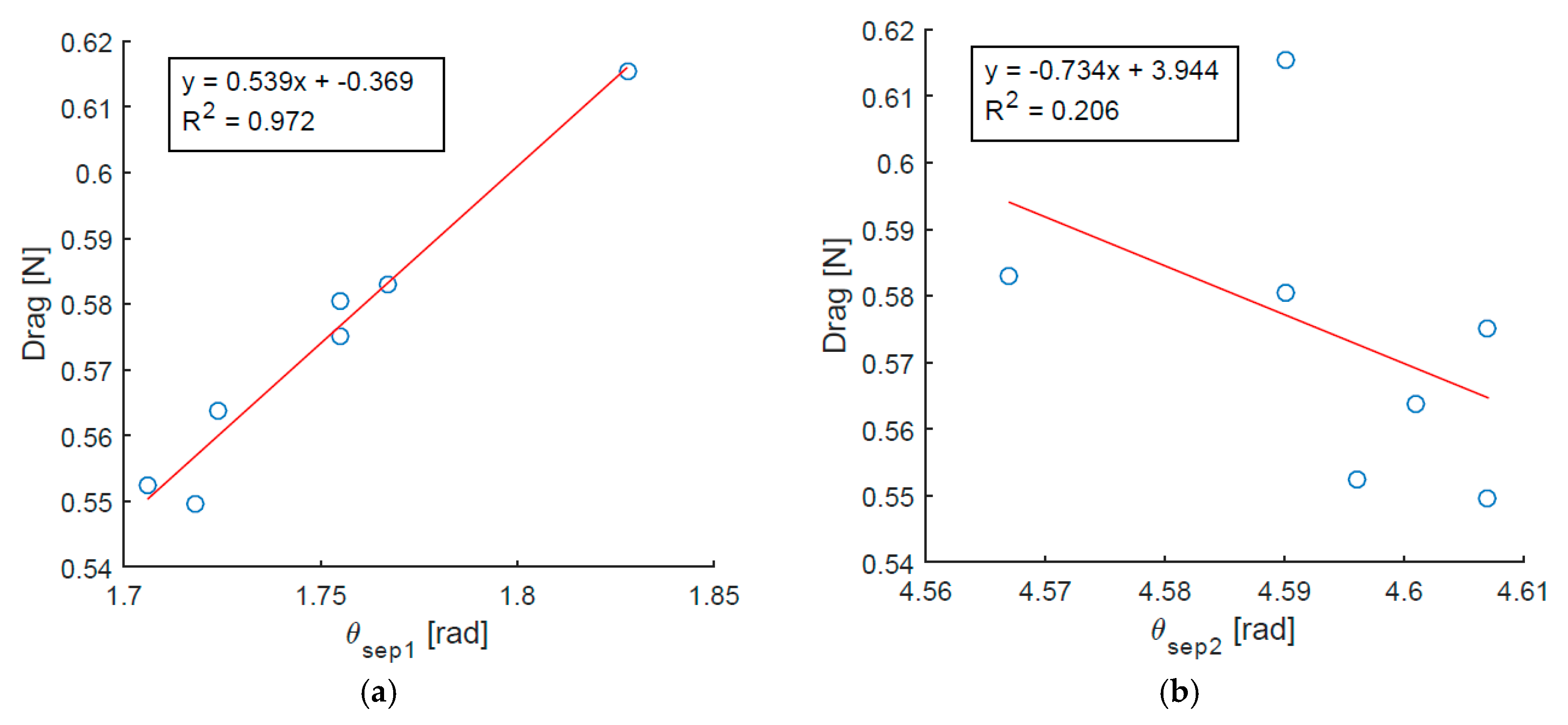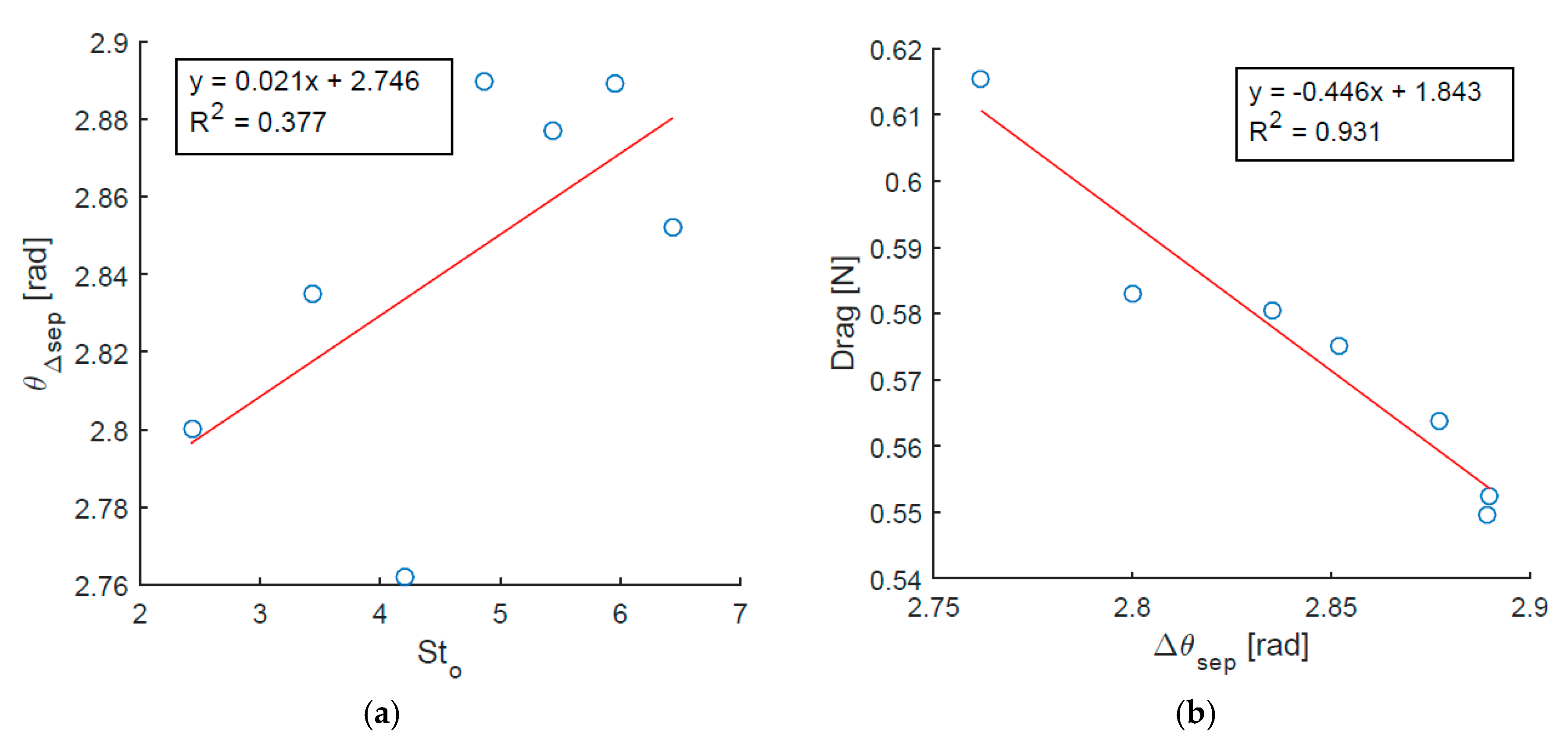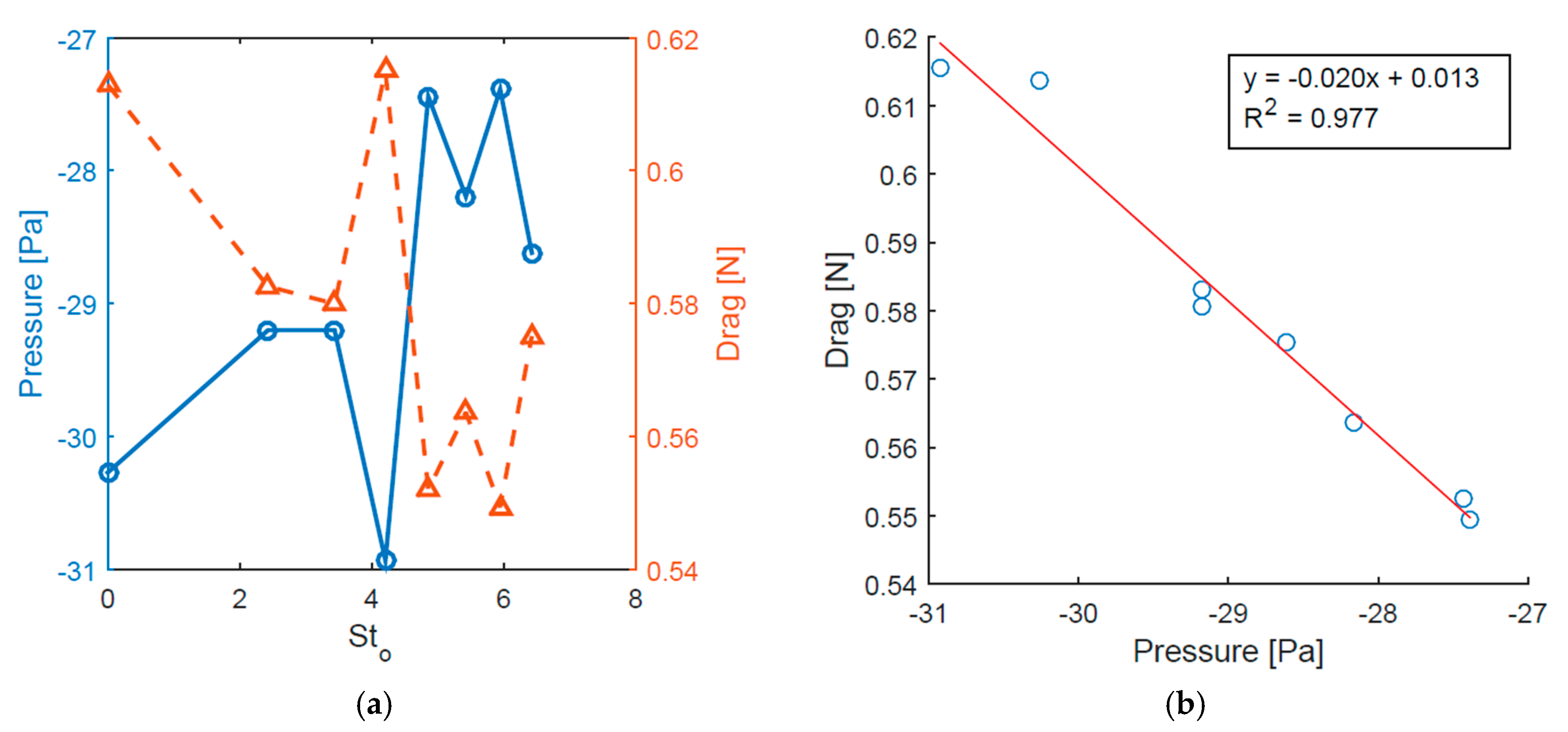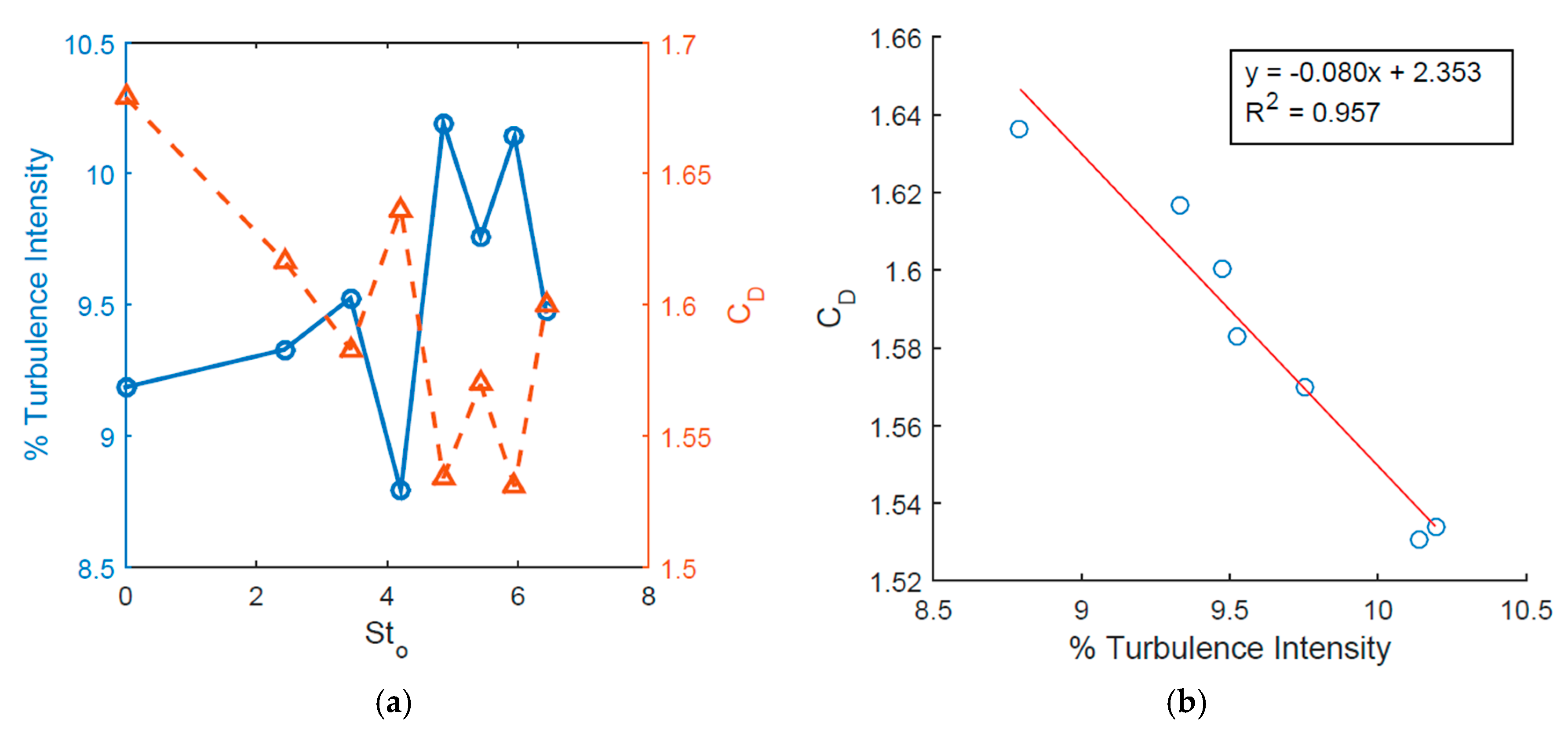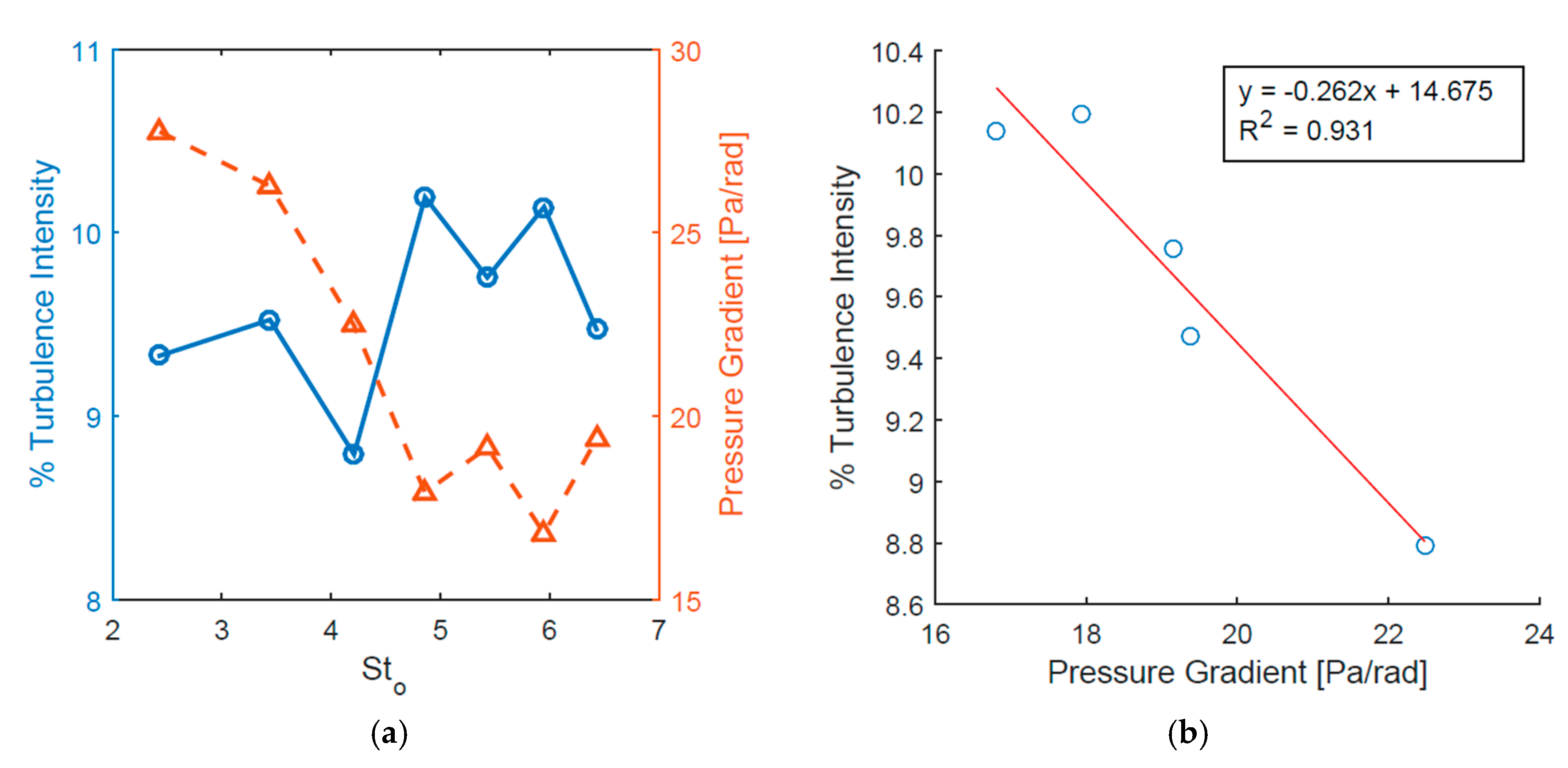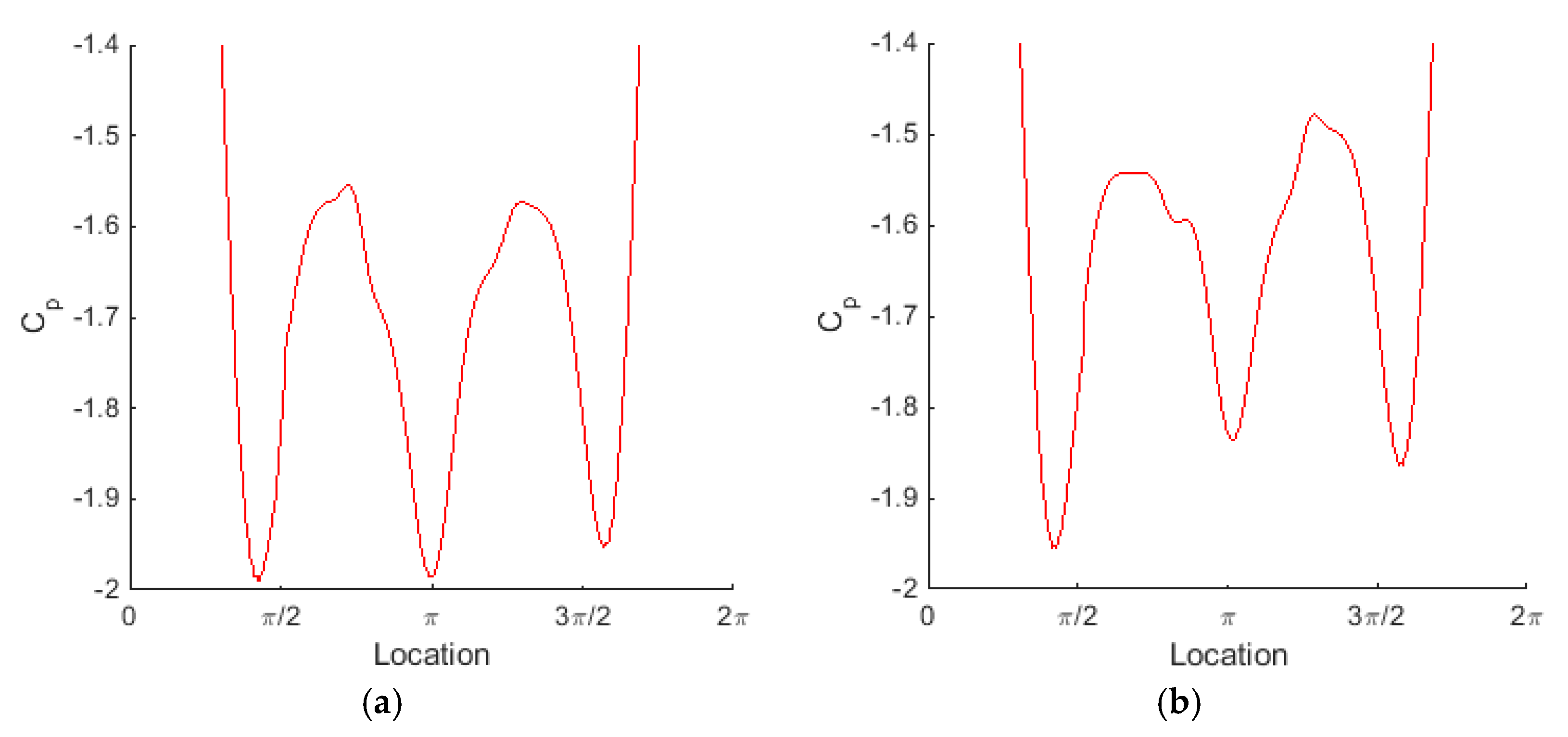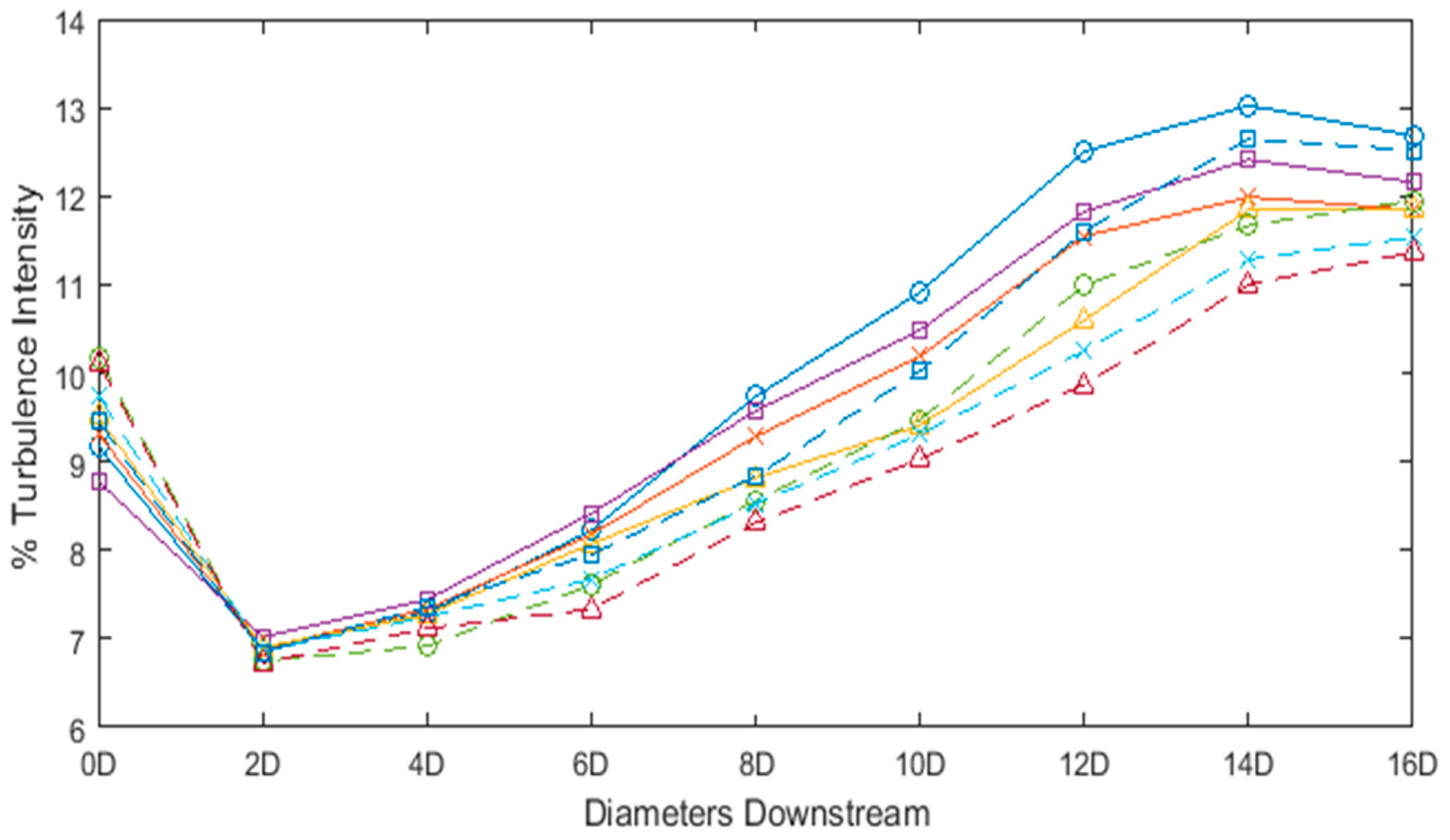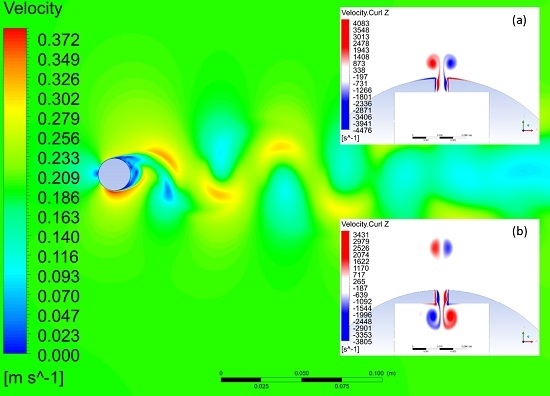1. Introduction
There is an increased drive among industries and policy makers to reduce the amount of carbon dioxide emissions using renewable energy sources and to improve the efficiency of current energy conversion processes. Evidence of this can be seen in the Clean Sky 2 program, an innovation program bringing together the European aviation industry and academia, to achieve 50% reduction in fuel consumption and carbon dioxide emissions by 2020 [
1]. Renewable energy sources are increasingly coming to the fore as a means to cut carbon emissions; tidal energy could theoretically provide 1 TW of energy from the more accessible coastal regions [
2]. Synthetic jet actuators can help provide potential gains, some marginal and some significant, in improving the efficiencies in both these areas. The outcomes of the present research may add to the progression and development of active flow control through the characterisation of the use of synthetic jet actuators for a cylinder in cross flow.
In recent years, synthetic jet actuators have proven to be useful devices for a wide range of flow control applications [
3]. Synthetic jets have been implemented to enhance heat transfer through turbulent mixing [
4] as well as being utilised to modify the boundary layer to notably increase lift and decrease drag forces experienced by a body [
5]. Studies using NACA0015 aerofoils have achieved a 100% increase in lift and 26.5% decrease in the corresponding drag [
6]. Other works have shown increases of 80% in lift as well as increasing the stall angle from 12° to 18° [
7]. These changes in the performance of an aerofoil have significant implications on both the payload an aircraft can carry as well as its fuel economy. These optimum operating points are often characterised by a dimensionless actuation frequency
(Equation (1)):
where
is the jet actuation frequency,
is a characteristic length scale (e.g., chord length) and
is the freestream velocity.
Synthetic jet actuators are zero net mass flux devices that can alter lift and drag forces by modifying the boundary layer and wake for a body in cross-flow. Boundary layer modification by a synthetic jet emanating from a surface is achieved through a propagating train of vortices. These vortices are created by an oscillating diaphragm within a cavity inside the body [
8,
9]. As the fluid passes over the sharp edge of the orifice, the shear flow causes the fluid to roll up into a vortex [
10]. If the diaphragm deflection amplitude is sufficiently large, the vortex separates from the orifice. On separation, the vortex ring moves with a near constant velocity in a direction perpendicular to its orifice exit plane (at least in quiescent fluid) as a result of the hydrodynamic impulse and thereby momentum is imparted on the surrounding fluid [
11,
12]. Due to the repeated oscillation of the diaphragm, vortices are ejected periodically from the orifice. Thus, a jet is ‘synthesized’ from the surrounding fluid, which imparts momentum to the boundary layer without adding net mass flux [
10]. The physical behaviour of a synthetic jet actuator and its optimal design criteria can be described by lumped element or reduced-order models [
4,
13,
14], using a combination of analytical modelling and empirical coefficients which can be determined through calibration [
4]. In cross-flow, the synthetic jet alters the viscous sublayer passing over a body. This alteration modifies the location of the separation point on the surface of the body. By altering the separation point as well as the characteristics of the downstream wake, synthetic jet actuation allows for the lift and drag forces experienced by the object to be altered [
10,
15,
16,
17,
18].
Another area of interest, other than flow around streamlined aerofoils, is how synthetic jets can alter flow around bluff bodies such as large pylons, e.g., onshore wind turbines, tidal turbine mounts or the risers used for offshore platforms, deep-water wind turbines or bridge sections [
19,
20,
21]. Through periodic vortex shedding, unwanted vibrations can be induced in the structure that can ultimately lead to failure. Synthetic jet actuators could be used to alter the wake produced by a structure and hence reduce the magnitude and/or frequency that a structure oscillates at, hence decreasing the chance of failure. When turbines are implemented in arrays, the wake from one device can affect turbines positioned in its wake, causing a reduction in efficiency [
22]. Synthetic jet actuators could be used to alter these wakes and thus increase the efficiency of the array or at least decrease the turbulence intensity experienced by a structure downstream.
Previous flow control work has predominantly focused on aerofoil geometries with air as the fluid. Recently, experimental investigations into active flow control for a circular cylinder in cross-flow have been conducted with water as the fluid, which have shown drag reductions of 20% to 29% [
23,
24]. Numerical approaches using large eddy simulation (LES) for active drag control for a two-dimensional cylinder in cross-flow by jet actuation have achieved drag reductions of 13%, as reported by Catalano et al. [
25]. The optimum location of the synthetic jet orifice has been shown to be at a position perpendicular to the freestream [
25]. Higher order methods such as the spectral element method are typically applied to direct numerical simulation (DNS) but have also been applied to LES [
26]. More recently, spectral element or
hp finite element methods have also been applied to more complex configurations [
27,
28]. The use of such methods allows for more accurate simulation of complete internal flows such as those of micropumps [
28,
29], which function similarly to synthetic jet actuators. In the present study, ANSYS Fluent will be used to conduct simulations. Currently, these higher order methods are unavailable for transient simulations in this commercial software package and therefore the unsteady Reynolds-averaged Navier-Stokes (URANS) computational fluid dynamics (CFD) approach with the transition shear stress transport (SST) turbulence model will be used instead, as described in more detail in
Section 2. The numerical work presented here focuses on the effect of varying synthetic jet actuation frequency on drag and lift coefficients, pressure coefficient and the turbulence intensity in the wake of a circular cylinder in cross-flow.
2. Numerical Approach
The numerical model was developed using a combination of ANSYS Component System ICEM and ANSYS Fluent for the case of flow around a circular cylinder. Due to limitations of the commercial software, no higher order methods could be used for a time-marching solution. Computational grids for two geometries were developed; flow around a cylinder of diameter
mm (
Figure 1) and flow around the same cylinder with a cavity embedded within the body and a
mm wide rectangular orifice located at the top of the cylinder perpendicular to the freestream (
Figure 2). The cylinder and orifice dimensions were identical to those used in a water tunnel experiment in the research group [
23]. As the periodic vortex shedding from the cylinder and the operation of a synthetic jet was time dependent, a time marching solution was applied.
An unsteady RANS simulation approach was implemented using the transition SST turbulence model as closure. The
model preforms well at predicting the behaviour of turbulent shear flows, such as those found in the wake of a cylinder where periodic vortex shedding has been established. Yet the
model performs poorly when dealing with adverse pressure gradients, such as those found after the separation point on the surface of a cylinder in cross-flow [
30]. For a more accurate flow behaviour in the boundary layer, the
model can be used. This model has proved reliable in the modelling of two-dimensional boundary layers with both adverse and favourable pressure gradients, decelerating and accelerating flow, making it more appropriate when dealing with separated flows [
30,
31]. One drawback of the
model is its inability to resolve unsteady turbulent structures and free shear flows, such as those found in jets [
32]. The transition SST model combines aspects of these two models and is better adapted at dealing with the flow regimes associated with a cylinder in cross-flow. This is achieved by utilising the
model in regions close to the wall boundary and the
model in the regions away from the wall. It is also more suitable for modelling free shear layers associated with separated wakes and jets [
33]. Out of most common RANS turbulence models, the SST model has been shown to achieve vortex-shedding Strouhal numbers closest to those obtained through LES [
34].
The semi-implicit method for pressure-linked equations (SIMPLE) scheme was used for the pressure-velocity coupling. The discretised momentum and pressure correction equations are solved implicitly, whereas the velocity correction is solved explicitly, thus resulting in a semi-implicit method. Second order upwind spatial discretisation was used for all variables, in combination with the least square cell-based method for the gradients.
Through an iterative design process (
Table 1), a computational grid was constructed with results that are independent of the mesh density. For two-dimensional simulations, the expected drag coefficient
RMS lift coefficient
and vortex shedding Strouhal number
are well established, with respective values of 1.74, 1.42 and 0.26 for flow around a cylinder at a Reynolds number
= 3900 [
25,
35]. The works of Beaudan and Moin [
35] and Catalano et al. [
25] were conducted using DNS and LES, respectively, for a 19-mm diameter cylinder and freestream velocity of 0.296 m/s. To attain the same
for the 20-mm diameter cylinder in the present study, the freestream velocity at the inlet is set to a 0.312 m/s. For all cases (both actuated and unactuated), the turbulence intensity at the velocity inlet is set to 5%. The computational grid has been refined until the numerical model achieved results sufficiently close to those reported in literature (see
Table 2), using
,
,
and the coefficient of pressure at the rear of the cylinder
as reference values. Utilising the URANS approach with the transition SST turbulence model allowed for savings in both computational time and solution file size. A time step of 0.1 ms was used to ensure a Courant-Friedrichs-Lewy (CFL) condition of less than unity.
The final computational grid contains 253,000 elements. The inclusion of the synthetic jet cavity and orifice further increased the total number of elements to 333,000. The density of the mesh was highest at the synthetic jet orifice and cavity, as well as at the surface of the cylinder. The mesh density was increased here to capture the small-scale vortical structures accurately. The mean aspect ratio of the mesh was 6.6, with a mean quality of 0.997. The dimensionless size of the first cell layer near the wall (
) did not exceed 1.0. A structured mesh was used to minimise computational time. The grid was aligned parallel to the freestream flow away from the cylinder surface and aligned with the cylinder surface in an O-grid structure close to the cylinder surface (
Figure 3). In this way, all elements in these regions are orientated in the general direction of the flow. By aligning the orientation of the grid with the flow in that region, the risk of false diffusion when using the upwind scheme can be eliminated and a more physically accurate solution is obtained [
36].
Upon achieving a computational grid capable of producing accurate results for a cylinder in cross-flow at
= 3900, the synthetic jet actuator geometry was incorporated into the design (
Figure 3). Previous research by Catalano et al. [
25] excluded the synthetic jet cavity and orifice. Instead, a velocity inlet boundary condition was applied to a 0.135 mm section of the cylinder surface to act as a synthetic jet orifice outlet. By using an alternating velocity inlet boundary condition on the surface of the cylinder, as opposed to modelling an actual cavity and orifice, a realistic synthetic jet would be unable to form. In the absence of an orifice and internal cavity, the flow separation near the sharp orifice edge would not lead to a realistic vortex formation [
10]. The inclusion of the fluid-filled cavity and orifice (see
Figure 2 and
Figure 3) allows for a more accurate modelling of synthetic jet formation. To verify the performance of the present numerical model, the computational grid with the inclusion of the cavity and orifice was compared with the work of Holman et al. [
37], which focused on the formation criterion for synthetic jets in quiescent flow.
Quiescent flow simulations were conducted with the present model at a jet Reynolds number
of 190, 255 and 479 and a fixed jet Stokes number of
= 15.8.
Figure 4a shows how the vortex sheets produced at the orifice roll up during the blowing phase. When the vortical structures are strong enough to avoid re-entrainment into the cavity during the suction phase, the pair of counter-rotating vortices propagates away from the orifice and moves with a near constant velocity in a direction perpendicular to the plane of the orifice (
Figure 4b). During the suction phase, a new vortical structure forms within the internal cavity and the process repeats itself. Subsequent periodic ejections of vortices from the orifice ultimately lead to a train of counter-rotating vortices and, after some periods, establish the fully formed synthetic jet flow field, including the internal flow dynamics within the cavity and orifice.
Once the numerical model was shown to capture the formation of a synthetic jet, the operation of the actuation device in cross-flow was considered. A ‘pseudo diaphragm’ was used in the form of a velocity inlet boundary condition, located at the base of the cavity with a user-defined function (UDF) to produce the appropriate oscillating velocity (Equation (2)):
where
is the peak velocity at the orifice,
represents time and the factor 10 is the ratio of the diaphragm cross-sectional area to the orifice cross-sectional area.
To verify the numerical model, the jet operating conditions (summarized in
Table 3) are based on the jet Strouhal number
, Stokes number
and Reynolds number
, as used in the work of Catalano et al. [
25]. All three dimensionless numbers are set to produce comparable synthetic jets, in spite of differing cavity and orifice geometries for actuation devices [
38] and are defined by Equations (3)–(6). The synthetic jet orifice used by Catalano et al. [
25] has a width of
mm, driven at frequencies between 50 Hz and 360 Hz. For the present study, a 1 mm wide synthetic jet orifice is used. To achieve the same values for
,
and
as Catalano et al. [
25], the synthetic jet is operated at lower actuation frequencies, between 0.9 Hz and 6.6 Hz. It should be noted that the work of Catalano et al. [
25] used a velocity inlet boundary condition at the orifice, without internal cavity flow; hence, no realistic roll up of vortical structures would occur. The addition of the fluid-filled cavity and orifice in the present study should allow for more accurate modelling as actual vortical structures were produced.
Despite the present study and the work of Catalano et al. [
25] being carried out at the same freestream Reynolds number, the two cases use different dimensionless actuation frequencies
. For the present study,
ranges from 0.05 to 0.42, whereas the values for Catalano et al. [
25] range from 3.2 to 23.1. This is due to the different jet orifice sizes. It was decided to fix
,
and
at identical values to yield an appropriate comparison between cylinders at the same freestream Reynolds number, similar outer diameter and freestream velocity but having different synthetic jet orifice sizes. All three of these values (
,
and
) are fixed, as opposed to only fixing the dimensionless actuation frequency
, as done in other studies [
3,
6,
16,
17].
3. Results and Discussion
The work of Catalano et al. [
25] at
= 3900 was used as a reference for the synthetic jet operating parameters of the present study. To the best of the authors’ knowledge, there are no DNS results or other LES simulation results available in the scientific literature for the case of a cylinder in cross-flow with the inclusion of a synthetic jet actuator. The results of Catalano et al. [
25] for a synthetic jet orifice located at
to the freestream flow were not presented specifically for that location, but rather in a three-dimensional surface plot. The results for the drag coefficient
against orifice location and actuation frequency were inferred from these results (
Figure 5). To produce the same jet Strouhal number
, Stokes number
and Reynolds number
, the pseudo diaphragm for the present study was driven at frequencies
between 0.9 and 6.7 Hz, at similar conditions to Catalano et al. [
25]. At these frequencies, a similar overall
modification trend was observed, with
decreasing overall from a jet Stokes number
= 2.43 to 4.86 and then increasing again from
= 4.86 to 6.43 (see
Figure 5). However, a noticeable deviation from the
results presented by Catalano et al. [
25] was observed at
= 4.21. For this case, the pseudo diaphragm was driven at a frequency of 2.83 Hz, the same frequency as the natural shedding of vortices from the cylinder in cross-flow. This deviation from the overall trend could be the result of a weak feedback loop [
39] between the synthetic jet frequency and the cylinder’s vortex shedding frequency. Operating at frequencies from 50 to 360 Hz, Catalano et al. [
25] would have been well beyond the vortex shedding frequency and thus no feedback loop would be present.
It should be recalled that the results of Catalano et al. [
25] were produced with an alternating velocity inlet boundary condition on the surface of the cylinder. The absence of internal vortex formation within the cavity could be an additional reason for the deviation between the results of Catalano et al. [
25] and those of the present study in certain cases (
Figure 5).
The root-mean-squared lift coefficient
experienced by the cylinder was also altered by the variation of synthetic jet actuation frequency. The trend in the drag coefficient due to increasing the actuation frequency closely matched the modification in RMS lift coefficient (
Figure 6). However, the same level of agreement in the
and
trends was not observed in experimental measurements in comparable conditions [
23,
24] and was not presented in other numerical studies [
25].
Time averaging of the near field and far field of the cylinder was carried out to identify why the values of the drag coefficient
and RMS lift coefficient
were modified. The averaging was carried out over three vortex shedding cycles, capturing the shedding of six vortices from the cylinder. A sampling rate of 33 Hz was used, since it was found that further increasing this sampling rate yielded no change in values. Near-field locations of interest were: (i) the stagnation point at the front of the cylinder (
= 0); (ii) the top and bottom separation points
and
; (iii) and the angle between these two separation points
(
Figure 7). The position of a stagnation point was determined by examination of the pressure on the surface of the cylinder. To determine the point at which flow separates from the cylinder, the wall shear stress
was used to calculate the dimensionless skin friction as
. The two separation points are determined by the location where the skin friction equals zero. Both surface pressure and wall shear stress were recorded at 1016 locations on the surface of the cylinder, allowing for sufficiently accurate positioning. Looking first at the stagnation point on the surface of the cylinder, there was small change in position and only a slight variation in pressure,
= 22.6 Pa with a standard deviation of
= 0.1 Pa. Thus, the effect of the synthetic jet is weak at this location (
), far upstream of the synthetic jet orifice.
For the case of an aerofoil, it has been shown that synthetic jet actuation can delay separation and hence reduce drag [
10,
15,
16,
17,
18]. For the present case, the positions of the top and bottom separation points
and
repond differently as the actuation frequency is varied. The top separation point location is only weakly correlated to an increase in actuation frequency (
Figure 8a). For all cases, separation occurs downstream of the synthetic jet orifice, which is located at a fixed position of
=
1.57 rad. Thus, the actuator is always acting on decelerating flow that has not yet separated, although subjected to an adverse pressure gradient. However, for the bottom separation point—located on the opposite side to the synthetic jet orifice—a strong correlation is found between the actuation frequency and the separation point location, as evidenced by a high coefficient of determination R
2 = 0.908 in
Figure 8b. The higher the actuation frequency, the more the bottom separation point moves downstream, towards the rear of the cylinder (
Figure 8b).
Although the top separation point location
is only weakly correlated to the actuation frequency, a strong correlation is observed between the top separation point location
and the drag force. When flow separation occurs closer to the front of the cylinder (and hence closer to the synthetic jet orifice), the drag force on the cylinder is lower (
Figure 9a). In the investigated range, the top separation point location varies by 0.12 rad (7°), whereas the bottom separation point varies by only 0.04 rad (2°). Conversely, the bottom separation point location
is only weakly correlated with the drag force (
Figure 9b).
While the bottom separation point location
shows a clear linear dependence on actuation frequency, this is much less pronounced for the top separation point. As such, the angle between the separation points
is also just weakly correlated with the actuation frequency (
Figure 10a). A stronger relationship is observed between
and the drag force (R
2 = 0.931). As
increases, the drag force decreases (
Figure 10b). This contrasts the known relationship between the separation point and drag for aerofoils, where delaying separation results in a drag reduction [
10,
15,
16,
17,
18].
Ultimately, the modification in drag coefficient
is the result of a changing surface pressure distribution. Since the drag force integration contains
(Equation (7)), any negative pressure between
=
/2 and 3
/2 gives a positive force in the
direction. The drag force per meter span is given by:
A strong correlation is observed between the drag and the minimum pressure over the rear half of the cylinder (
Figure 11a). As this pressure decreases, the drag increases.
The near-wall turbulent kinetic energy
directly at the rear of the cylinder (
) has been monitored. As before, averaging was carried out over three vortex shedding cycles at a sampling rate of 33 Hz. This was done to determine how the jet operating conditions altered the turbulence intensity (Equations (8) and (9)) and if indeed any correlation exists between the turbulence intensity
and the drag coefficient
. The turbulent quantities are defined as follows:
where
represents the standard deviation of the flow velocity and
is the mean flow velocity, with subscripts
,
and
denoting the three spatial directions.
is the turbulent kinetic energy obtained from the two-dimensional CFD calculation.
This relationship between turbulence intensity at the rear of the cylinder and the drag coefficient is found to be particularly strong (
Figure 12b). For all actuated and unactuated cases, whenever the turbulence intensity at
increases, there is a corresponding decrease in the drag coefficient (
Figure 12a). This suggests that high momentum fluid is being injected into the near-wall sections of the boundary layer, which is in agreement with other studies [
9,
40]. It is worth noting that the freestream turbulence intensity applied at the velocity inlet boundary condition is fixed at 5% in the present study, in contrast to Morenko and Fedyaey [
41] who varied the inlet turbulence intensity to investigate its effect on the lift and drag force on a circular cylinder in cross-flow.
During the suction phase, retarding flow would be accelerated towards the orifice and entrained into the cavity with higher momentum fluid in the freestream outside the viscous sublayer being drawn into the boundary layer. During the ejection phase, further momentum is added to the retarding viscous sublayer. As previously discussed, the synthetic jet orifice for all cases modelled was upstream of the separated flow region. This means that the synthetic jet would be operating in a region with an adverse pressure gradient and so an increase in momentum would be indicated by a decrease in the magnitude of this adverse pressure gradient across the jet orifice.
A positive correlation is found between the reduction in magnitude of the surface pressure gradient
across the orifice (at
) and the turbulence intensity
(at
). The perceived link between the two variables is most pronounced at the higher end of the frequency range under investigation, from a jet Stokes number
between 4.2 and 6.4. Where the pressure gradient magnitude across the orifice decreases, a higher turbulent intensity is observed at the rear of the cylinder, suggesting agreement with other published results [
9,
40] on the advantageous increase in momentum of the fluid downstream of the orifice, thus modifying
(
Figure 13a).
Exactly how these mechanisms affect the surface pressure coefficient
can be seen more readily upon closer inspection of
Figure 13 and
Figure 14. Since the stagnation pressure remains unchanged across the range of actuation frequencies, a direct comparison of
plots can be carried out. Comparing two cases of jet Stokes number
= 2.43 and 4.86 (
Figure 14), the corresponding increase in turbulence intensity
from 9.4% to 10.2% appears to transform the pressure distribution, decreasing the magnitude of all maxima and minima of
(
Figure 14). It appears that the bulk of the drag reduction is due to the reduction in the pressure magnitude between
and
and hence the reduction in the positive force in the
direction (Equation (7)). It is interesting to note the asymmetry when comparing the
= 2.43 case (
Figure 14a) with the
= 4.86 case (
Figure 14b). The asymmetry of the time-averaged
results offers little correlation between the degree of asymmetry and the drag reduction; only the decrease in the pressure magnitude accounts for this reduction.
The downstream flow domain was observed from the lee of the cylinder at a distance ranging from zero to 16 diameters (16) downstream. For the spatial averaging aspect, the properties of the flow domain were recorded along a series of lines extending in the direction and spaced 2D apart from 0 to 16 from the lee of the cylinder. As previously mentioned, the turbulence intensity at the freestream velocity inlet was fixed at 5%. How the turbulence intensity downstream of the cylinder varies with actuation frequency can provide valuable information for wind or tidal turbine arrays, particularly if the jet operating conditions that yield the minimum drag coefficient and RMS lift coefficient values were to have a negative effect at far field downstream locations, e.g. in the form of increased turbulence intensity. This turns out not to be the case, as described below.
Across all cases modelled, unactuated or actuated, regardless of frequency, at no point in the flow domain does the averaged turbulence intensity return to 5%. The minimum turbulence intensity of 6.7% occurs at 2
D downstream of the cylinder. The near-wall turbulence intensity in the lee of the cylinder ranges from 10.2% (for
) to 8.8% (for
= 4.21). A common trend for all cases in
Figure 15 is that the turbulence intensity decreases in the near-wake, over the first distance of 2
. Beyond 2
downstream, the turbulence intensity increases with distance. The peak turbulence intensity (for the unactuated case and actuated cases with
= 2.43, 3.44, 4.21 and 6.43) ranges from 11.9% to 13.0% at a downstream distance of 14
from the cylinder. After this point, there is a small decrease before the end of the flow domain is reached. The cases for
= 4.86, 5.43 and 5.95 have not yet reached a maximum turbulence intensity at the end of the flow domain. The flow domain would need to be extended further downstream to fully ascertain where the turbulence intensity reaches its peak value for all conditions under investigation. However, since the rate at which the turbulence intensity increases drops towards the end of the flow domain, the maximum turbulence intensity for these cases is not expected to exceed the value of 13.0% observed for the other cases.
As previously noted, in the near wake directly in the lee of the cylinder, as the turbulence intensity increases,
decreases. However, for the far wake region beyond 8
D downstream of the cylinder, the opposite trend is observed for all cases (both actuated and unactuated); namely, a lower turbulence intensity corresponds to a decrease in
(
Figure 15).
4. Conclusions
Using unsteady RANS simulations with the transition SST turbulence model, a significant modification of the drag coefficient
and RMS lift coefficient
for a circular cylinder in cross-flow has been observed, for a freestream Reynolds number
and a range of synthetic jet Stokes numbers from
= 2.4 to 6.4. Overall, the trend in
modification agrees with the work of Catalano et al. [
25], with a general decrease in
achieved at
= 4.9 for a fixed jet Reynolds number of
= 12. It was also observed that the modification of the RMS lift coefficient
was closely coupled with the modification of the drag coefficient
.
Previous research has used the dimensionless actuation frequency
for comparison of synthetic jet operating conditions and the effects on flow control for NACA aerofoil geometries [
3,
6,
16,
17,
42]. Despite a similar-sized cylinder and comparable freestream velocity, the results of the present study and Catalano et al. [
25] are characterised by different dimensionless actuation frequencies
, due to the different sized synthetic jet orifices used in both studies. The present study opted for an orifice width of 1 mm, identical to the size used in water tunnel experiments in the research group, but larger than the 0.13 mm wide orifice used by Catalano et al. [
25]. However, the three dimensionless jet operating parameters
,
and
were maintained the same as Catalano et al. [
25] for comparison of the vortex formation process. The optimum drag coefficient
and RMS lift coefficient
reduction occurs at
= 0.4 for the present study and at
= 19.5 for Catalano et al. [
25], but otherwise similar trends have been observed.
Decreases in the magnitude of the adverse surface pressure gradient across the synthetic jet orifice indicate an increase in the momentum of the viscous sublayer. When the magnitude of the pressure gradient across the orifice decreases, there is an increase in turbulence intensity at the rear of the cylinder. This increase in the strength of the vortical structures at the rear of the cylinder appears to be responsible for the decrease in drag coefficient .
Additionally, an increase in turbulence intensity in the lee of the cylinder also corresponds to a decrease in the turbulence intensity further downstream in the cylinder wake, beyond downstream. This could be a useful insight for structures or devices implemented in arrays, such as tidal turbines and wave energy devices, or the risers used for offshore platforms and deep-water wind turbines. By operating the synthetic jet actuator to minimise the mean drag and RMS lift forces experienced by the structure, the turbulence intensity downstream of the structure will also be minimised. Thus, the ideal synthetic jet operating condition for drag and lift reduction would have a beneficial effect on the flow conditions of downstream devices.
